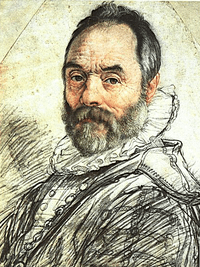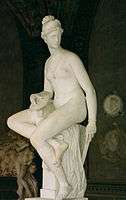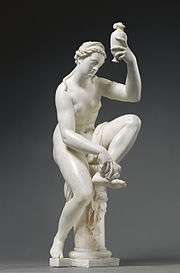Giambologna

Giambologna (1529 – 13 August 1608) — born Jean Boulogne (and incorrectly known as Giovanni da Bologna or Giovanni Bologna) — was a Flemish sculptor based in Italy, celebrated for his marble and bronze statuary in a late Renaissance or Mannerist style.

Biography
Giambologna was born in Douai, Flanders (now in France), in 1529. After youthful studies in Antwerp with the architect-sculptor Jacques du Broeucq,[1] he moved to Italy in 1550 and studied in Rome, making a detailed study of the sculpture of classical antiquity. He was also much influenced by Michelangelo, but developed his own Mannerist style, with perhaps less emphasis on emotion and more emphasis on refined surfaces, cool elegance, and beauty. Pope Pius IV gave Giambologna his first major commission, the colossal bronze Neptune and subsidiary figures for the Fountain of Neptune (the base designed by Tommaso Laureti, 1566) in Bologna. Giambologna spent his most productive years in Florence, where he had settled in 1553. In 1653 he was named a member (Accademico) of the prestigious Accademia delle Arti del Disegno, just founded by the Duke Cosimo I de' Medici, on 13 January 1563, under the influence of the painter-architect Giorgio Vasari, becoming also one of the Medicis' most important court sculptors. He died in Florence at the age of 79; the Medici had never allowed him to leave Florence, as they rightly feared that either the Austrian or Spanish Habsburgs would entice him into permanent employment. He was interred in a chapel he designed himself in the Santissima Annunziata.
Work

Giambologna became well known for a fine sense of action and movement, and a refined, differentiated surface finish. Among his most famous works are the Mercury (of which he did four versions), poised on one foot, supported by a zephyr. The god raises one arm to point heavenwards in a gesture borrowed from the repertory of classical rhetoric[2] that is characteristic of Giambologna's maniera.
His other most famous work is the Rape of the Sabine Women (1574–82) a marble sculpture which is featured prominently in the Loggia dei Lanzi in Florence's Piazza della Signoria. This impressive sculpture which includes three full figures was carved from a single piece of marble. Giambologna carved it without a subject in mind, and the name Rape of the Sabine Women was given after it was in place in the Loggia. The sculpture was produced for Francesco Medici, Grand Duke of Tuscany. Another of his marbles, Hercules Slaying a Centaur was also placed in the Loggia dei Lanzi in 1599.[3]
Giambologna's several depictions of Venus established a canon of proportions, and set models for the goddess' representation that were influential for two generations of sculptors in Italy and in the North. He created allegories strongly promoting Medicean political propaganda, such as Florence Defeating Pisa and, less overtly, Samson Slaying a Philistine, for Francesco de' Medici (1562).[4]
The equestrian statue of Cosimo I de' Medici also in Florence, was completed by his studio assistant Pietro Tacca.
Giambologna provided as well as many sculptures for garden grottos and fountains in the Boboli Gardens of Florence and at Pratolino, and the bronze doors of the cathedral of Pisa. He created the bronze sea-horses and some other sculptures for Bartolomeo Ammannati's Fountain of Neptune, Florence.[5]
For the grotto of the Villa Medicea of Castello he sculpted a series of studies of individual animals, from life, which may now be viewed at the Bargello. Small bronze reductions of many of his sculptures were prized by connoisseurs at the time and ever since, for Giambologna's reputation has never suffered eclipse.
Giambologna was an important influence on later sculptors through his pupils Adriaen de Vries and Pietro Francavilla who left his atelier for Paris in 1601, as well as Pierre Puget who spread Giambologna's influence throughout Northern Europe, and in Italy on Pietro Tacca, who assumed Giambologna's workshop in Florence, and in Rome on Gian Lorenzo Bernini and Alessandro Algardi.
 Architettura exemplifies the long limbs of Giambologna's influential ideal female type Bargello
Architettura exemplifies the long limbs of Giambologna's influential ideal female type Bargello Female Figure, 1571-73, J. Paul Getty Museum
Female Figure, 1571-73, J. Paul Getty Museum
References
- ↑ R. Wellens, Jacques du Broeucq, sculpteur et architecte de la renaissance (Brussels) 1962
- ↑ Compare the figure of Plato in Raphael's School of Athens.
- ↑ Avery, Charles (1987). Giambologna: The Complete Sculpture. Mt. Kisco, N.Y.: Moyer Bell. ISBN 0918825393.
- ↑ The marble figure for a Medici fountain, the only large marble group by Giambologna to have left Florence, was given to the Duke of Lerma, then to Charles, Prince of Wales at the time of negotiations for the Spanish Match; it was given by George III to Sir Thomas Worsley, at Hovingham Hall, Norfolk; it was purchased in 1953 for the Victoria and Albert Museum through the Art Fund (; ).
- ↑ https://books.google.ca/books?id=3UIYAAAAYAAJ&pg=PA199&dq=FOUNTAIN+OF+NEPTUNE++florence+bronze+sea-horses+by+Giovanni+da+Bologna&hl=en&sa=X&ved=0ahUKEwikp_Ss4-jUAhUjw4MKHUc0CeoQ6AEIKjAB#v=onepage&q=FOUNTAIN%20OF%20NEPTUNE%20%20florence%20bronze%20sea-horses%20by%20Giovanni%20da%20Bologna&f=false, p=199
Sources
- Gloria Fossi, et al., Italian Art, Florence, Giunti Gruppo Editoriale, 2000, ISBN 88-09-01771-4.
- Giambologna, 1529-1608 : sculptor to the Medici : an exhibition organised by the Arts Council of Great Britain etc., catalogue edited by Charles Avery and Anthony Radcliffe. London, Arts Council of Great Britain, 1978, ISBN 0-7287-0180-4.
External links
| Wikimedia Commons has media related to Giambologna. |
- Biography with a portrait on kfki.hu
- Giambologna on mega.it
- "Model of a River God". Sculpture. Victoria and Albert Museum. Retrieved 2007-09-22.
- "Samson and a Philistine". Sculpture. Victoria and Albert Museum. Archived from the original on 2009-07-09. Retrieved 2011-03-15.
- "The Flagellation of Christ". Red Wax Sculpture. Queensland Art Gallery. Archived from the original on 2011-03-12. Retrieved 2011-03-15.
- "Rape of Proserpina". Bronze. Norton Simon Museum. Retrieved 2015-02-20.
- A Tour of the location of Giambologna's major works in Florence